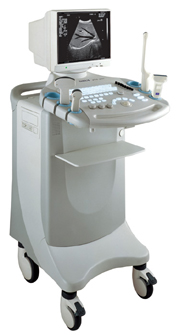Medical Ultrasound Imaging
Wednesday, 8 May 2024
'Ultrasound imaging' p4 Searchterm 'Ultrasound imaging' found in 68 articles 3 terms [ • ] - 65 definitions [• ] Result Pages : •
Echoes of deep lying structures within the body do not always come from the latest emitted sound pulse and can produce an aliasing artifact. Aliasing lowers the frequency components when the pulse repetition frequency is less than 2 times the highest frequency of a Doppler signal. This artifact can be problematical at Spectral or Color Doppler examinations. Aliasing of the data displayed in pulsed wave technology is utilized as a benefit in determining transitions from laminar to turbulent flow. See also Ultrasound Imaging Modes. •  From SIUI Inc.;
From SIUI Inc.;'Dedicated to ultrasound industry, Shantou Institute of Ultrasonic Instruments, Inc. (SIUI) has launched Apogee 3500, the Digital Color Doppler Ultrasound Imaging System. With latest imaging technologies, high-definition image quality and excellent practical functions, the Apogee 3500 offers optimal solutions for clinical ultrasonic examination.' 'The Apogee 3500 is available with many high-density, super broadband and multi-frequency probes, such as convex, micro-convex, linear, vaginal, rectal and phased array probes, which are widely applied for different clinical diagnoses, including abdomen (liver, kidney, gall-bladder, pancreas), gynecology (uterus, ovary), obstetrics (early pregnancy, basic OB, complete OB, multi gestation, fetal echo), cardiology (adult and pediatric cardiology), small parts (thyroid, galactophore, testicles, neonate), peripheral vascular and prostate.'
Device Information and Specification
CONFIGURATION
Normal system, color - gray scale(256)
Linear, convex and phased array
PROBES STANDARD
2.0 MHz ~ 12.0 MHz, broad band, tri-frequency
B-mode (B, 2B, 4B), M-mode, B/M-mode, real-time compound imaging, panoramic imaging, trapezoidal imaging (linear probes), spectrum Doppler (PWD and CWD), color Doppler flow imaging (CDFI), color power angio (CPA), tissue harmonic imaging (THI)
IMAGING OPTIONS
Real-time ZOOM, zoom rate and position selectable
OPTIONAL PACKAGE
H*W*D m
1.29 * 0.52 * 0.75
WEIGHT
110 kg
POWER REQUIREMENT
AC 220V/110V, 50Hz/60Hz
POWER CONSUMPTION
0.6 KVA
•
Arrays are spatial arrangements of transducers or transducer elements. Array types used in ultrasound imaging:
•
annular array - elements arranged in concentric circles;
•
curved array - elements arranged along a convex curve;
•
linear array - elements are arranged along a line;
•
rectangular array - elements arranged in a rectangular pattern.
See also Composite Array. •
An image artifact is any image attribute, which is not present in the original imaged object. An image artifact is sometime the result of an improper operation of the imager, and in other times a consequence of natural processes or properties of the human body. Artifacts in diagnostic ultrasound are a reflection or an echo, which appears on the display and represents the real anatomical structure not correctly. An artifact can be a false, multiple or misleading information introduced by the imaging system or by interaction of ultrasound with the adjacent tissue. Artifacts in ultrasound can be classified as to their source like e.g.:
•
physiologic (motion, different sound velocities, acoustical impedances of tissue);
•
hardware (dimension of the ultrasound beam and the transducer array);
•
Image artifacts can occur in each medical ultrasound. Then an interpretation of the image is complicated and can eliminate the structural information of objects looking for. See also Ultrasound Imaging Procedures. •
Attenuation is the reduction of power, for example due to the passage through a medium or electrical component. In ultrasound imaging, attenuation means the decrease in amplitude and intensity as a sound wave travels through a medium. In ultrasound attenuation is often characterized as the half-value layer, or the half-power distance. These terms refer to the distance that ultrasound will travel in a particular tissue before its energy is attenuated to half its original value. Attenuation originates through:
•
divergence of the wavefront;
•
absorption of wave energy;
•
elastic reflection of wave energy;
•
elastic scattering of wave energy.
A thick muscled chest wall will offer a significant obstacle to the transmission of ultrasound. Non-muscle tissue such as fat does not attenuate acoustic energy as much. The half-value layer for bone is still less than muscle, that's why bone is such a barrier to ultrasound. See also Attenuation Coefficient, and Derated Quantity. Further Reading: Basics:
Result Pages : |
Medical-Ultrasound-Imaging.com
former US-TIP.com
Member of SoftWays' Medical Imaging Group - MR-TIP • Radiology TIP • Medical-Ultrasound-Imaging
Copyright © 2008 - 2024 SoftWays. All rights reserved.
Terms of Use | Privacy Policy | Advertise With Us
former US-TIP.com
Member of SoftWays' Medical Imaging Group - MR-TIP • Radiology TIP • Medical-Ultrasound-Imaging
Copyright © 2008 - 2024 SoftWays. All rights reserved.
Terms of Use | Privacy Policy | Advertise With Us
[last update: 2023-11-06 01:42:00]




